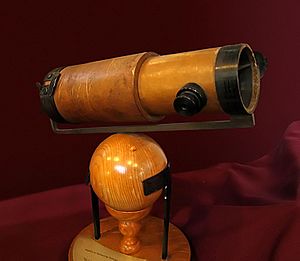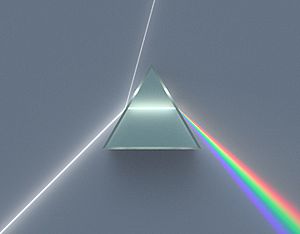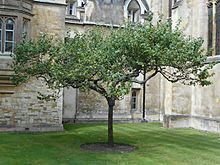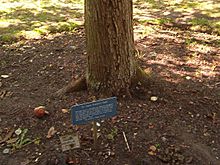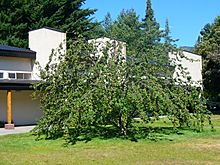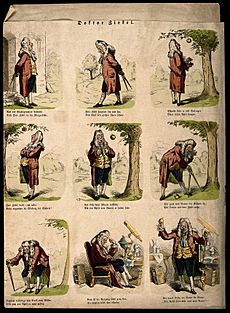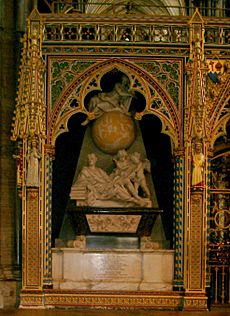Isaac Newton facts for kids
Quick facts for kids
Isaac Newton
|
|
|---|---|
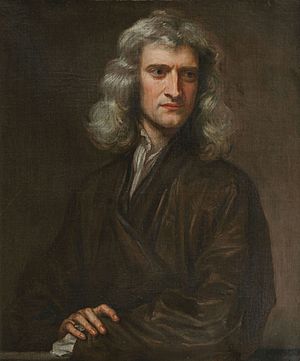
Portrait of Newton at 46 by Godfrey Kneller, 1689
|
|
| Born | 4 January 1643 [O.S. 25 December 1642] |
| Died | 31 March 1727 (aged 84) [O.S. 20 March 1726] |
| Resting place | Westminster Abbey |
| Education | Trinity College, Cambridge (M.A., 1668) |
| Known for |
List
Newtonian mechanics
universal gravitation calculus Newton's laws of motion optics binomial series Principia Newton's method Newton's law of cooling Newton's identities Newton's metal Newton line Newton–Gauss line Newtonian fluid Newton's rings Standing on the shoulders of giants List of all other works and concepts |
| Awards |
|
| Scientific career | |
| Fields |
|
| Institutions | |
| Academic advisors |
|
| Notable students | |
| Influences | |
| Influenced |
List
In the natural sciences and mathematics
|
| Member of Parliament for the University of Cambridge |
|
| In office 1689–1690 |
|
| Preceded by | Robert Brady |
| Succeeded by | Edward Finch |
| In office 1701–1702 |
|
| Preceded by | Anthony Hammond |
| Succeeded by | Arthur Annesley, 5th Earl of Anglesey |
| 12th President of the Royal Society | |
| In office 1703–1727 |
|
| Preceded by | John Somers |
| Succeeded by | Hans Sloane |
| Master of the Mint | |
| In office 1699–1727 |
|
| 1696–1699 | Warden of the Mint |
| Preceded by | Thomas Neale |
| Succeeded by | John Conduitt |
| 2nd Lucasian Professor of Mathematics | |
| In office 1669–1702 |
|
| Preceded by | Isaac Barrow |
| Succeeded by | William Whiston |
| Personal details | |
| Political party | Whig |
| Signature | |
 |
|
Sir Isaac Newton FRS (25 December 1642 – 20 March 1726/27) was an English mathematician, physicist, astronomer, alchemist, theologian, and author who was described in his time as a natural philosopher. He was a key figure in the Scientific Revolution and the Enlightenment.
Contents
Early life
Isaac Newton was born (according to the Julian calendar in use in England at the time) on Christmas Day, 25 December 1642 (NS 4 January 1643), "an hour or two after midnight", at Woolsthorpe Manor in Woolsthorpe-by-Colsterworth, a hamlet in the county of Lincolnshire. His father, also named Isaac Newton, had died three months before.
When Newton was three, his mother remarried and went to live with her new husband, the Reverend Barnabas Smith. Newton's maternal grandmother, Margery Ayscough (née Blythe), took care of him. Newton disliked his stepfather and did not want his mother to marry him. Newton's mother had three children (Mary, Benjamin, and Hannah) from her second marriage.
The King's School
From the age of about twelve until he was seventeen, Newton was educated at The King's School in Grantham. He studied Latin, Ancient Greek and probably some basic mathematics. When his stepfather died, his mother withdrew him form school. She wanted him to become a farmer, an occupation he hated.
Henry Stokes, master at The King's School, persuaded his mother to send him back to school.
University of Cambridge
In June 1661, Newton was admitted to Trinity College at the University of Cambridge. His uncle Reverend William Ayscough, who had studied at Cambridge, recommended him to the university. He was awarded a scholarship in 1664, which covered his university costs for four more years until the completion of his MA.
Soon after Newton obtained his BA degree at Cambridge in August 1665, the university temporarily closed as a precaution against the Great Plague. In April 1667, Newton returned to the University of Cambridge, and in October he was elected as a fellow of Trinity.
His academic work impressed the Lucasian professor Isaac Barrow, who became master of Trinity College two years later; in 1669, Newton succeeded him, only one year after receiving his MA. Newton was elected a Fellow of the Royal Society (FRS) in 1672.
Discoveries
Newton explained the workings of the universe through mathematics. He described laws of motion and gravitation. These laws are math formulas that explain how objects move when a force acts on them. Isaac published his most famous book, Principia, in 1687 while he was a mathematics professor at Trinity College, Cambridge. In the Principia, Isaac explained three basic laws that govern the way objects move. He then described his idea, or theory, about gravity. Gravity is the force that causes things to fall down. If a pencil fell off a desk, it will land on the floor, not the ceiling. In his book Isaac also used his laws to show that the planets revolve around the suns in orbits that are oval, not round. Isaac also discovered diffraction. This led him to enter the field of physics, where he prospered.
Isaac Newton was a brilliant scientist and inventor who made significant contributions to the field of physics, mathematics, and optics. Here are some of his most famous inventions and discoveries:
- Newton's laws of motion. These laws set the foundation for modern classical mechanics and describe the relationship between an object's motion and the forces acting upon it.
- Law of universal gravitation: This theory laid forth the idea that all particles in the universe exert some gravitational force and explained the motion of the planets around the sun.
- Reflecting telescope: This invention used a curved mirror to reflect and focus light, which eliminated color refraction and boasted 40x magnification. To this day, nearly all astronomical observatories use a variant of Newton's original design.
- Calculus: Newton's invention of calculus was a significant breakthrough in mathematics and has been used in countless applications.
- Perfect coin: Newton was appointed the Warden of the Royal Mint in 1696 and went on to become the Master of the Mint in 1699. During his tenure, he developed a method for minting coins that prevented counterfeiting.
- Optics: Newton made significant contributions to our understanding of the refraction of light and developed a theory of color based on the observation that a prism separates white light into a spectrum of colors.
- Shape of orbits: Newton's early discoveries included his work on the shape of orbits, which he was hesitant to publish due to modesty and controversy.
- The reflecting sextant: This invention was used to measure the angle between two objects, such as the sun and the horizon, and was used for navigation at sea
Overall, Isaac Newton's inventions and discoveries have had a lasting impact on the world and continue to inspire scientists and researchers today.
Newton's Three Laws Of Motion
Following are the three laws of motion.
- The first law (Law of Inertia)
- Newton's first law of motion states is that an object that is not being pushed or pulled by some force will stay still, or will keep moving in a straight line at a steady speed. It is easy to understand that a rocket will not move unless something pushes or pulls it. It is harder to understand that an object will continue to move without help. Think of the rocket again. If someone is flying a rocket and jumps off before the rocket is stopped, what happens? The rocket continues on until it goes into space. The tendency of an object to remain still, or keep moving in a straight line at a steady speed is called inertia.
- The second law (Law of Acceleration)
- The second law explains how a force acts on an object. An object accelerates in the direction the force is moving it. If someone gets on a bicycle and pushes the pedals forward the bicycle will begin to move. If someone gives the bicycle a push from behind, the bicycle will speed up. If the rider pushes back on the pedals the bicycle will slow down. If the rider turns the handlebars, the bicycle will change direction. The formula showing this law is F=m*a, or the force acting on an object is equal to mass times acceleration.
- The third law (Law of Reciprocal Actions)
- The third law states that if an object is pushed or pulled, the object will be push or pull equally in the opposite direction. If someone lifts a heavy box, they use force to push it up. The box is heavy because it is producing an equal force downward on the lifter’s arms. The weight is transferred through the lifter’s legs to the floor. The floor presses upward with an equal force. If the floor pushed back with less force, the person lifting the box would fall through the floor. If it pushed back with more force the lifter would fly into the air.
The discovery of the Law of Gravitation
When most people think of Isaac Newton, they think of him sitting under an apple tree watching an apple fall. Some people even believe the apple fell onto his head. Newton understood that what makes things like apples fall to the ground is a specific kind of force — the force we call gravity. Newton thought that gravity was the force of attraction between two objects, such as an apple and the earth. He also thought that an object with more matter exerted the same force on smaller objects as they exerted on it. That meant that the large mass of the earth pulled objects toward it. That is why the apple fell down instead of up, and why people do not float in the air.
Isaac Newton went on thinking about gravity. Before Newton, people thought that only objects near to the earth would fall down. But Newton thought that gravity should not just be limited to the earth and the objects on it. What if gravity went to the moon and beyond?
Newton invented a formula for calculating the force of attraction between two bodies. He used it to calculate the force needed to keep the moon moving around the earth. Then he compared it with the force that made the apple fall downward. After allowing for the fact that the moon is much farther from the earth, and has a much greater mass, he discovered that the forces were the same. The moon is held in an orbit around the earth by the pull of earth’s gravity.
The formula invented by Newton is called the Law of gravitation.
Apple incident
Newton himself often told the story that he was inspired to formulate his theory of gravitation by watching the fall of an apple from a tree. The story is believed to have passed into popular knowledge after being related by Catherine Barton, Newton's niece, to Voltaire. Voltaire then wrote in his Essay on Epic Poetry (1727), "Sir Isaac Newton walking in his gardens, had the first thought of his system of gravitation, upon seeing an apple falling from a tree."
Although it has been said that the apple story is a myth and that he did not arrive at his theory of gravity at any single moment, acquaintances of Newton do confirm the incident, though not the version that the apple actually hit Newton's head.
John Conduitt, Newton's assistant at the Royal Mint and husband of Newton's niece, also described the event when he wrote about Newton's life:
In the year 1666 he retired again from Cambridge to his mother in Lincolnshire. Whilst he was pensively meandering in a garden it came into his thought that the power of gravity (which brought an apple from a tree to the ground) was not limited to a certain distance from earth, but that this power must extend much further than was usually thought. Why not as high as the Moon said he to himself & if so, that must influence her motion & perhaps retain her in her orbit, whereupon he fell a calculating what would be the effect of that supposition.
Various trees are claimed to be "the" apple tree which Newton describes. The King's School, Grantham claims that the tree was purchased by the school, uprooted and transported to the headmaster's garden some years later. The staff of the (now) National Trust-owned Woolsthorpe Manor dispute this, and claim that a tree present in their gardens is the one described by Newton. A descendant of the original tree can be seen growing outside the main gate of Trinity College, Cambridge, below the room Newton lived in when he studied there.
Impact
Isaac Newton’s calculations changed the way people understood the universe. No one had been able to explain why the planets stayed in their orbits. What held them up? Less than 50 years before Isaac Newton was born it was thought that the planets were held in place by an invisible shield. Isaac proved that they were held in place by the sun’s gravity. He also showed that the force of gravity was affected by distance and by mass. He was not the first to understand that the orbit of a planet was not circular, but more elongated, like an oval. What he did was to explain how it worked.
Sir Isaac Newton was the first to discover the laws of gravitation and the laws of motion. He also established a new field in mathematics known as calculus, though the German Gottfried Leibniz had developed the ideas at the same time. His work has greatly contributed in the areas of science and mathematics making him one of the most influential scientists in human history and one of the greatest mathematician of all times.
The great physicist, Albert Einstein, thought that Newton's idea of gravity was not completely accurate. He corrected many of the things that Newton did.
Later life and death
Toward the end of his life, Newton took up residence at Cranbury Park, near Winchester, with his niece and her husband, until his death. His half-niece, Catherine Barton, served as his hostess in social affairs at his house on Jermyn Street in London.
Newton died in his sleep in London on 20 March 1727 (OS 20 March 1726; NS 31 March 1727). He was given a ceremonial funeral, attended by nobles, scientists, and philosophers, and was buried in Westminster Abbey among kings and queens. He is also the first scientist to be buried in the abbey. Voltaire may have been present at his funeral. A bachelor, he had divested much of his estate to relatives during his last years, and died intestate. His papers went to John Conduitt and Catherine Barton.
After his death, Newton's hair was examined and found to contain mercury, probably resulting from his alchemical pursuits. Mercury poisoning could explain Newton's eccentricity in late life.
The epitaph
English poet Alexander Pope wrote the famous epitaph:
Nature, and Nature's laws lay hid in night.
God said, Let Newton be! and all was light.
But this was not allowed to be inscribed in the monument. The epitaph in the monument is as follows:
H. S. E. ISAACUS NEWTON Eques Auratus, / Qui, animi vi prope divinâ, / Planetarum Motus, Figuras, / Cometarum semitas, Oceanique Aestus. Suâ Mathesi facem praeferente / Primus demonstravit: / Radiorum Lucis dissimilitudines, / Colorumque inde nascentium proprietates, / Quas nemo antea vel suspicatus erat, pervestigavit. / Naturae, Antiquitatis, S. Scripturae, / Sedulus, sagax, fidus Interpres / Dei O. M. Majestatem Philosophiâ asseruit, / Evangelij Simplicitatem Moribus expressit. / Sibi gratulentur Mortales, / Tale tantumque exstitisse / HUMANI GENERIS DECUS. / NAT. XXV DEC. A.D. MDCXLII. OBIIT. XX. MAR. MDCCXXVI,
which can be translated as follows:
Here is buried Isaac Newton, Knight, who by a strength of mind almost divine, and mathematical principles peculiarly his own, explored the course and figures of the planets, the paths of comets, the tides of the sea, the dissimilarities in rays of light, and, what no other scholar has previously imagined, the properties of the colours thus produced. Diligent, sagacious and faithful, in his expositions of nature, antiquity and the holy Scriptures, he vindicated by his philosophy the majesty of God mighty and good, and expressed the simplicity of the Gospel in his manners. Mortals rejoice that there has existed such and so great an ornament of the human race! He was born on 25th December 1642, and died on 20th March 1726.
Personality
Newton had a close friendship with the Swiss mathematician Nicolas Fatio de Duillier, who he met in London around 1689—some of their correspondence has survived. Their relationship came to an abrupt and unexplained end in 1693, and at the same time Newton suffered a nervous breakdown.
Newton was relatively modest about his achievements. In a memoir, Newton wrote, "I do not know what I may appear to the world, but to myself I seem to have been only like a boy playing on the sea-shore, and diverting myself in now and then finding a smoother pebble or a prettier shell than ordinary, whilst the great ocean of truth lay all undiscovered before me."
Interesting facts about Isaac Newton
- Newton was born prematurely and was very small; his mother Hannah Ayscough reportedly said that he could have fit inside a quart mug.
- In his middle school years Newton was bullied. He revenged by becoming the top-ranked student.
- As a student, he built sundials and models of windmills.
- At Cambridge, Newton perfomed valet duties for a while, to cover his university costs.
- He was a devout but unorthodox Christian. He privately rejected the doctrine of the Trinity.
- He refused to take holy orders in the Church of England, unlike most members of the Cambridge faculty of the day.
- Beyond his studies, Newton dedicated much of his time to the study of alchemy and biblical chronology.
- Newton served two brief terms as Member of Parliament for the University of Cambridge, in 1689–1690 and 1701–1702.
- He was knighted by Queen Anne in 1705.
- Although it was claimed that he was once engaged, Newton never married.
- He served as Warden (1696–1699) and Master (1699–1727) of the Royal Mint, as well as president of the Royal Society (1703–1727).
- Working at the Royal Mint, Newtonfound out that 20 percent of the coins taken in during the Great Recoinage of 1696 were counterfeit. As a result of his report to the Lords Commissioners of His Majesty's Treasury, the royal proclamation of 22 December 1717 forbade the exchange of gold guineas for more than 21 silver shillings. This moved Britain to its first gold standard.
- In his position at the Royal Society, Newton made an enemy of John Flamsteed, the Astronomer Royal, by prematurely publishing Flamsteed's Historia Coelestis Britannica, which Newton had used in his studies.
- Newton had political and personal ties to the Whig party.
- Newton was invested in the South Sea Company and lost some £20,000 (£4.4 million in 2020) when it collapsed in around 1720.
- Einstein kept a picture of Newton on his study wall alongside ones of Michael Faraday and James Clerk Maxwell.
- Woolsthorpe Manor is a Grade I listed building by Historic England through being his birthplace and "where he discovered gravity and developed his theories regarding the refraction of light".
- In 1816, a tooth said to have belonged to Newton was sold for £730 (US$3,633) in London to an aristocrat who had it set in a ring. Guinness World Records 2002 classified it as the most valuable tooth, which would value approximately £25,000 (US$35,700) in late 2001. Who bought it and who currently has it has not been disclosed.
- The mathematician Joseph-Louis Lagrange said that Newton was the greatest genius who ever lived.
- In a 2005 survey of members of Britain's Royal Society (formerly headed by Newton) asking who had the greater effect on the history of science, Newton or Albert Einstein, the members deemed Newton to have made the greater overall contribution.
- In 1999, an opinion poll of 100 of the day's leading physicists voted Einstein the "greatest physicist ever," with Newton the runner-up, while a parallel survey of rank-and-file physicists by the site PhysicsWeb gave the top spot to Newton.
- The SI derived unit of force is named the newton in his honour.
Isaac Newton quotes
- “I do not know what I may appear to the world, but to myself I seem to have been only like a boy playing on the sea-shore, and diverting myself in now and then finding a smoother pebble or a prettier shell than ordinary, whilst the great ocean of truth lay all undiscovered before me.”
- “I can calculate the motion of heavenly bodies but not the madness of people.”
- “What we know is a drop, what we don't know is an ocean.”
- “Tact is the knack of making a point without making an enemy.”
- “Gravity explains the motions of the planets, but it cannot explain who sets the planets in motion.”
- “No great discovery was ever made without a bold guess.”
- “A man may imagine things that are false, but he can only understand things that are true.”
- “If I have ever made any valuable discoveries, it has been due more to patient attention, than to any other talent.”
Commemorations
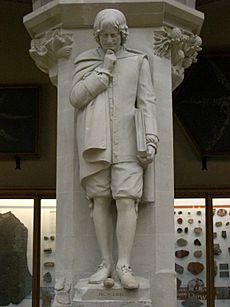
Newton's monument (1731) can be seen in Westminster Abbey, at the north of the entrance to the choir against the choir screen, near his tomb. It was executed by the sculptor Michael Rysbrack (1694–1770) in white and grey marble with design by the architect William Kent. The monument features a figure of Newton reclining on top of a sarcophagus, his right elbow resting on several of his great books and his left hand pointing to a scroll with a mathematical design. Above him is a pyramid and a celestial globe showing the signs of the Zodiac and the path of the comet of 1680. A relief panel depicts putti using instruments such as a telescope and prism.
From 1978 until 1988, an image of Newton designed by Harry Ecclestone appeared on Series D £1 banknotes issued by the Bank of England (the last £1 notes to be issued by the Bank of England). Newton was shown on the reverse of the notes holding a book and accompanied by a telescope, a prism and a map of the Solar System.
A statue of Isaac Newton, looking at an apple at his feet, can be seen at the Oxford University Museum of Natural History. A large bronze statue, Newton, after William Blake, by Eduardo Paolozzi, dated 1995 and inspired by Blake's etching, dominates the piazza of the British Library in London. A bronze statue of Newton was erected in 1858 in the centre of Grantham where he went to school, prominently standing in front of Grantham Guildhall.
Images for kids
-
Newton in 1702 by Godfrey Kneller
-
Facsimile of a 1682 letter from Newton to William Briggs, commenting on Briggs' A New Theory of Vision
-
Engraving of Portrait of Newton by John Vanderbank
-
Newton's own copy of Principia with Newton's hand-written corrections for the second edition, now housed at Wren Library at Trinity College, Cambridge
-
Coat of arms of the Newton family of Great Gonerby, Lincolnshire, afterwards used by Sir Isaac
See also
 In Spanish: Isaac Newton para niños
In Spanish: Isaac Newton para niños


